Use IMPORTRANGE to pull data from one Google Sheet to another.
By the way, we're Bardeen, we build a free AI Agent for doing repetitive tasks.
If you work with spreadsheets, you might love Bardeen's GPT in Spreadsheets feature. It helps automate data tasks and saves you time.
The IMPORTRANGE function in Google Sheets is a powerful tool that allows you to easily pull data from one spreadsheet into another. Whether you're working with large datasets or need to combine information from multiple sources, IMPORTRANGE streamlines the process and saves you time. In this step-by-step guide, we'll walk you through how to use IMPORTRANGE effectively, from understanding the basics to mastering advanced techniques and troubleshooting common issues.
Understanding the Basics of IMPORTRANGE
IMPORTRANGE is a function in Google Sheets that allows you to import data from one spreadsheet into another. It's a powerful tool for combining data from multiple sources or working with large datasets across different sheets. The primary syntax for using IMPORTRANGE is:
IMPORTRANGE("spreadsheet_url", "range_string")
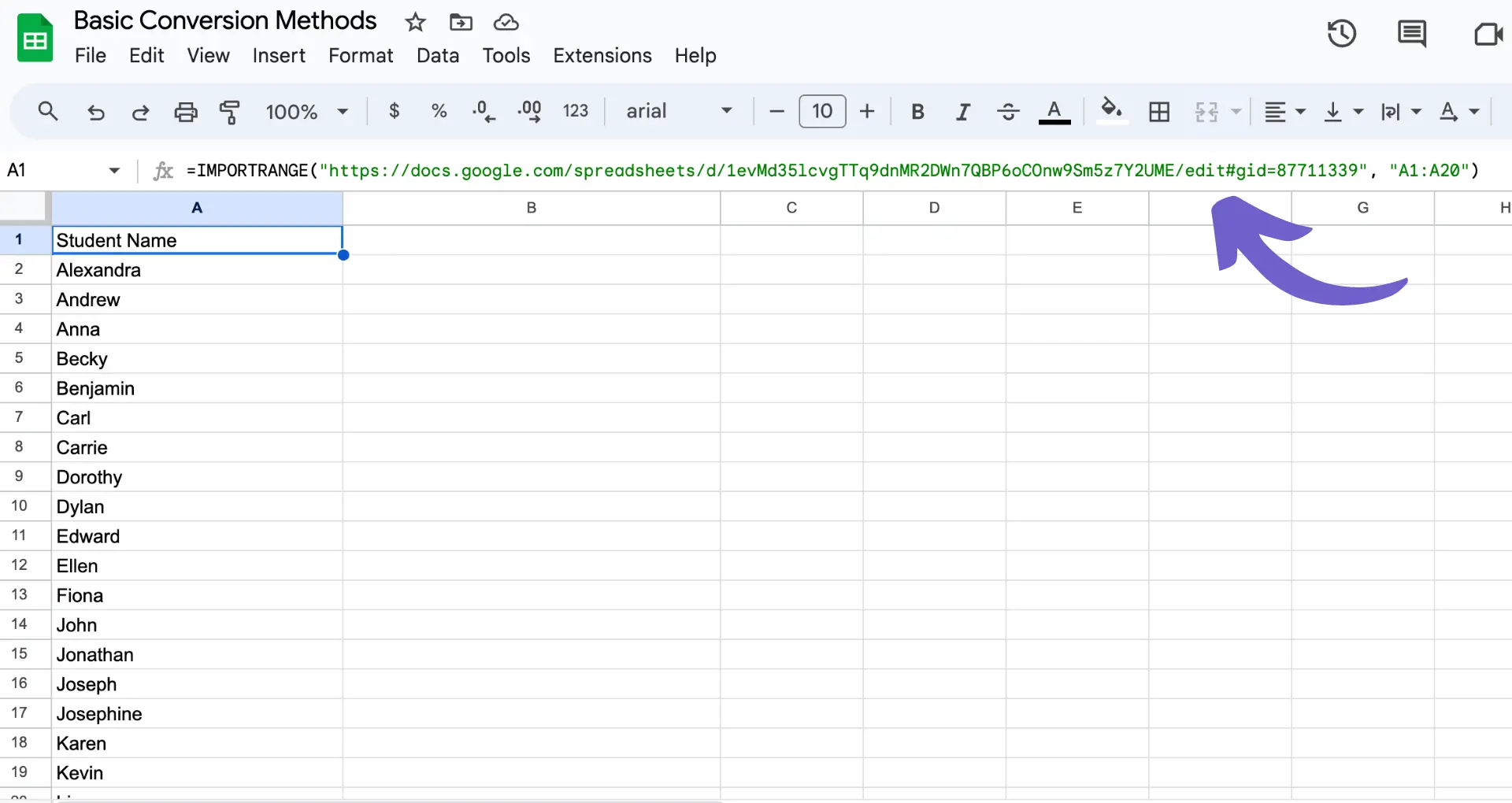
- spreadsheet_url: The URL of the source spreadsheet from which data will be imported. This value must be enclosed in quotation marks or reference a cell containing the URL.
- range_string: A string in the format "sheet_name!range" (e.g., "Sheet1!A2:B6") specifying the range to import. The sheet_name is optional; if omitted, IMPORTRANGE will import from the first sheet by default.
When using IMPORTRANGE for the first time between two spreadsheets, you'll need to grant permission for the destination sheet to access data from the source sheet. This ensures data security and prevents unauthorized access. For more advanced features, you can bring AI into your spreadsheet to enhance your workflow.
Setting Up Your First IMPORTRANGE
To start using IMPORTRANGE, open a new or existing Google Sheet where you want to import the data. In an empty cell, type the following formula:
=IMPORTRANGE("spreadsheet_url","range_string")
Replace "spreadsheet_url" with the URL of the source spreadsheet, enclosed in quotation marks. You can find the URL in the address bar when viewing the source spreadsheet.
Next, replace "range_string" with the range of cells you want to import, also enclosed in quotation marks. Use the format "Sheet1!A1:B5", where Sheet1 is the name of the sheet and A1:B5 is the range of cells.
Press Enter to complete the formula. If this is the first time you're importing data between these two spreadsheets, you'll see a #REF! error. Click on the error and select "Allow access" to grant permission for the destination sheet to access data from the source sheet.
Once permission is granted, the imported data will appear in your destination sheet. Any changes made to the source data will automatically update in the destination sheet, ensuring you always have the latest information. For more complex workflows, you can connect Google Sheets with other apps to automate your tasks.
Automate importing and updating data across sheets quickly. Integrate Google Sheets with Bardeen to connect your sheets and save time.
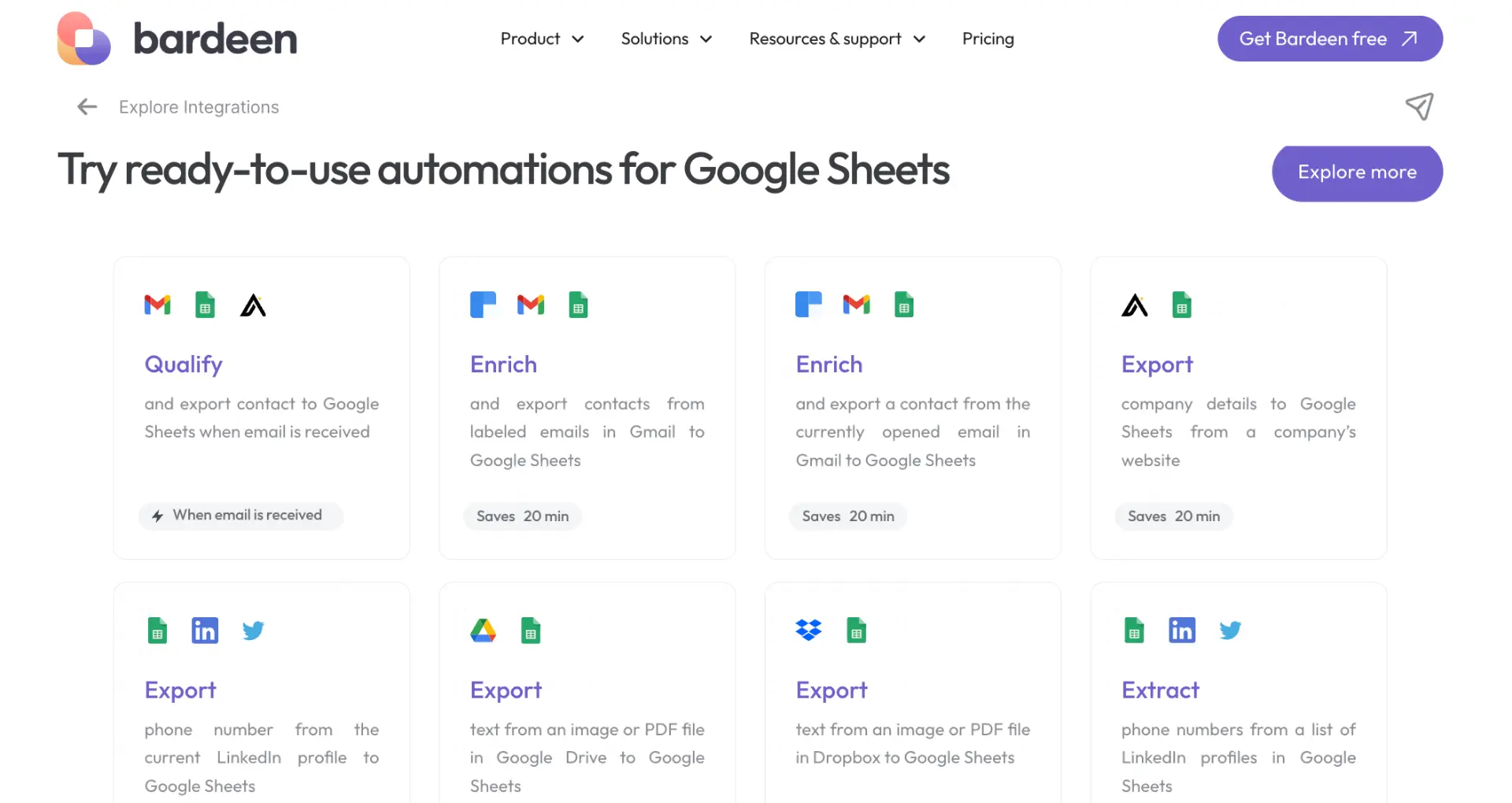
Handling Common Errors in IMPORTRANGE
When using the IMPORTRANGE function, you may encounter some common errors. Here are the typical errors and how to resolve them:
#REF! Error
The #REF! error occurs when the IMPORTRANGE formula is unable to find the specified sheet or range. This can happen if:
- The source spreadsheet or sheet has been deleted or renamed
- The range specified in the formula is incorrect or has been modified
- You don't have permission to access the source spreadsheet
To fix this error:
- Double-check the source spreadsheet URL and sheet name in the formula
- Verify that the range specified in the formula is correct
- Ensure you have permission to access the source spreadsheet
#ERROR! Error
The #ERROR! error typically indicates a problem with the IMPORTRANGE formula syntax. Common causes include:
- Missing or incorrect quotation marks around the spreadsheet URL or range
- Extra spaces in the formula
- Incorrect use of the function's parameters
To resolve this error, carefully review the formula and ensure that the syntax is correct, with proper quotation marks and no extra spaces.
Loading... Error
When you first use IMPORTRANGE to connect two spreadsheets, you may see a "Loading..." error. This is not actually an error, but a prompt to allow access between the spreadsheets. Click "Allow access" to grant permission and the data will load.
If you continue to see the "Loading..." message after allowing access, try these troubleshooting steps:
- Refresh the spreadsheet
- Double-check that you have permission to access the source spreadsheet
- Verify that the source spreadsheet and sheet still exist and have not been renamed or deleted
By understanding these common IMPORTRANGE errors and how to handle them, you can more effectively use this powerful function to import data across Google Sheets. To further improve your spreadsheet workflows, consider using tools to connect Microsoft Excel seamlessly with other applications.
Advanced Techniques with IMPORTRANGE
IMPORTRANGE is a powerful function in Google Sheets, but its potential goes beyond basic usage. By combining it with other functions and using it creatively, you can take your data management and analysis to the next level.
Combining IMPORTRANGE with QUERY and FILTER
You can use IMPORTRANGE with functions like QUERY and FILTER to refine the imported data based on specific criteria. This allows you to pull in only the data you need, making your sheets more efficient and focused. Data enrichment can also enhance your analysis.
For example, to import data from a range and filter it to only include rows where the value in column 3 is greater than 1000, you could use:
=QUERY(IMPORTRANGE("spreadsheet_url","sheet_name!range"), "SELECT * WHERE Col3 > 1000")
Similarly, you can use FILTER with IMPORTRANGE to apply custom criteria to the imported data, like this:
=FILTER(IMPORTRANGE("spreadsheet_url","sheet_name!range"), IMPORTRANGE("spreadsheet_url","sheet_name!range")
Using IMPORTRANGE with Multiple Ranges or Sheets
IMPORTRANGE can handle multiple ranges or even multiple sheets, allowing you to consolidate data from various sources into a single location. To import multiple ranges from the same sheet, you can use an array formula like this:
={IMPORTRANGE("spreadsheet_url","sheet_name!range1"),IMPORTRANGE("spreadsheet_url","sheet_name!range2")}
To import data from different sheets, simply specify the sheet names in the range strings:
={IMPORTRANGE("spreadsheet_url","sheet1!range"),IMPORTRANGE("spreadsheet_url","sheet2!range")}
Automating Data Updates with IMPORTRANGE
By setting up IMPORTRANGE formulas in your sheets, you can automate data updates across multiple files. Any changes made to the source data will be automatically reflected in the destination sheet, keeping everything in sync without manual intervention. For help with automation, check out our automation field guide.
Bardeen's automation tools can save you time by automating repetitive tasks and keeping your data up-to-date. Learn how to scrape data from websites easily.
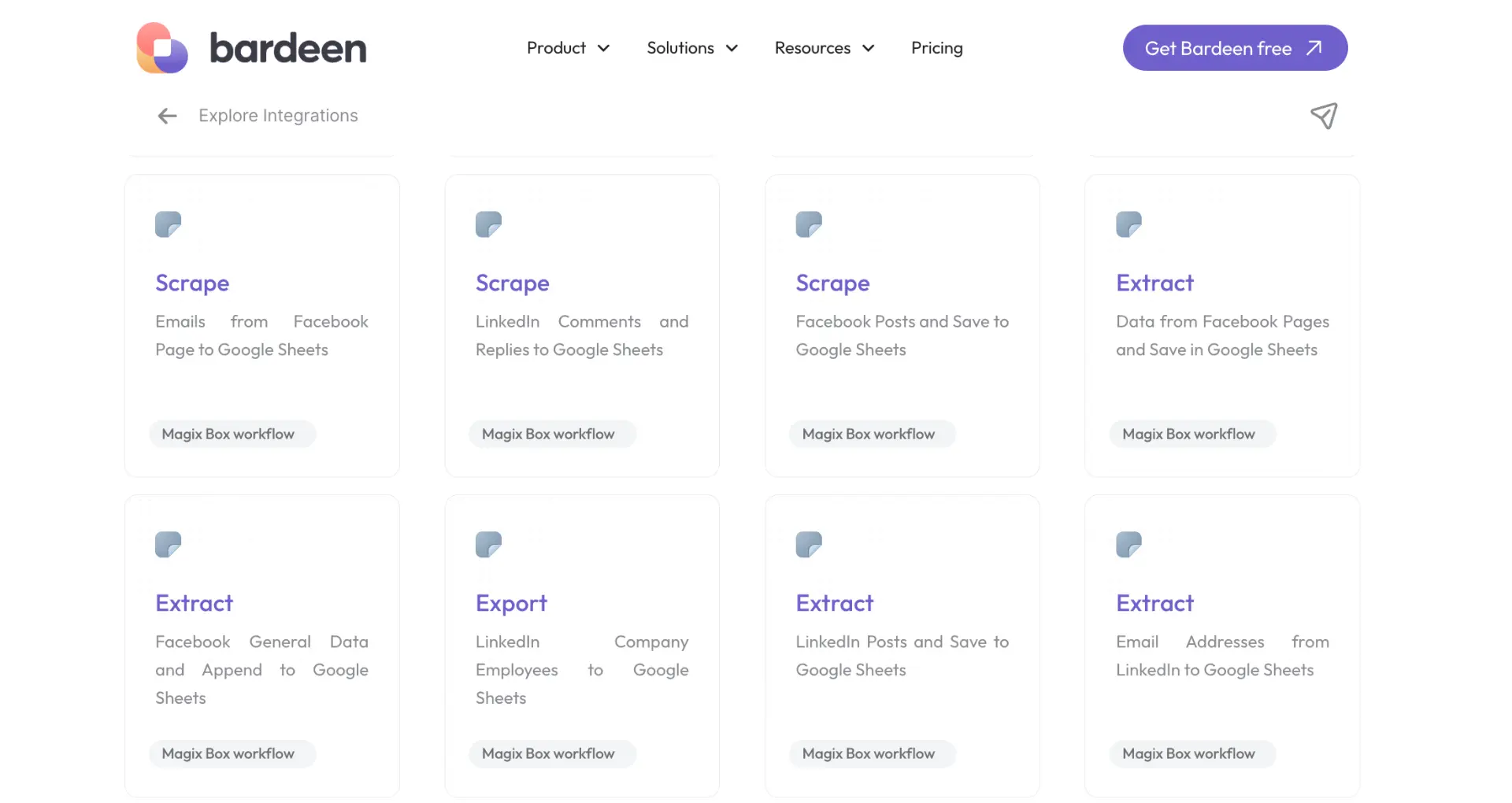
To ensure smooth automation, make sure to:
- Properly set up and maintain permissions for the source sheets
- Regularly check for and fix any broken links or references
- Optimize your sheet structure to minimize the number of IMPORTRANGE calls needed
By mastering these advanced techniques, you can harness the full power of IMPORTRANGE to streamline your data workflows, automate updates, and gain deeper insights from your spreadsheet data.
Security and Access Considerations
When using IMPORTRANGE, it's crucial to understand the security implications and manage access to your data properly. By default, IMPORTRANGE requires permission to access the source sheet, which helps protect your data from unauthorized access.
Granting Access to IMPORTRANGE
The first time you use an IMPORTRANGE formula, Google Sheets will prompt you to grant access to the source sheet. This permission is necessary for the function to retrieve data from the source and display it in the destination sheet.
It's important to note that:
- Only users with edit access to the destination sheet can grant permission for IMPORTRANGE
- The permission is granted to the specific IMPORTRANGE formula, not the entire sheet
- If the source sheet's URL or structure changes, you may need to re-grant permission
Protecting Sensitive Data
If you're working with sensitive data, take extra precautions when using IMPORTRANGE:
- Consider using alternative methods, like manual data entry or Google Apps Script, for highly confidential information
- Regularly audit your sheets for any unauthorized IMPORTRANGE formulas or unexpected data access
- Use data validation and conditional formatting to help identify and flag any suspicious data or changes
By understanding the security implications of IMPORTRANGE and following best practices for managing access, you can safely leverage this powerful function to share and sync data across your Google Sheets.
Optimizing Performance with IMPORTRANGE
When working with large datasets in Google Sheets, using the IMPORTRANGE function can sometimes lead to performance issues. Here are some tips to help optimize your sheets and minimize delays:
Reference Data on the Same Sheet When Possible
Instead of using IMPORTRANGE to pull data from another spreadsheet, consider manually copying the data to your current sheet. This eliminates the need for data to be fetched over the internet, resulting in faster computation and improved stability.
Use Closed Range References
When using functions like SUM or AVERAGE, opt for closed range references (e.g., A1:A10) instead of open range references (e.g., A:A). This ensures that Google Sheets only processes the necessary cells, rather than the entire column, resulting in faster calculations.
Optimize Volatile Functions
Functions like TODAY(), NOW(), RAND(), and RANDBETWEEN() are volatile and refresh frequently. To minimize their impact on performance:
- Use absolute references when referencing these functions to avoid unnecessary recalculations
- Minimize the number of cells containing volatile functions
Avoid Long Reference Chains
Reference chains, where one cell depends on another, can slow down your sheets. To avoid this:
- Use absolute references to directly reference the source data
- Break up complex formulas into smaller, more manageable parts
Manage Data Refresh Rates
If you must use IMPORTRANGE, consider the following:
- Limit the range of data being imported to only what is necessary
- Use the IMPORTRANGE function sparingly and combine data into fewer cells when possible
- Avoid using IMPORTRANGE in frequently updated cells or sheets
By following these tips and optimizing your use of IMPORTRANGE, you can significantly improve the performance of your Google Sheets, even when working with large datasets. For more advanced tips, check out web scraper extensions that can also help streamline your data management.
Bardeen can help you enrich LinkedIn profiles in Google Sheets automatically, saving you time and effort. Try it now!
Alternatives to IMPORTRANGE
While IMPORTRANGE is a popular function for importing data from one Google Sheet to another, there are some alternatives that you can consider for specific use cases:
Coupler.io
Coupler.io is a data integration tool that allows you to import data from various sources, including Google Sheets, into a destination sheet. Some benefits of using Coupler.io include:
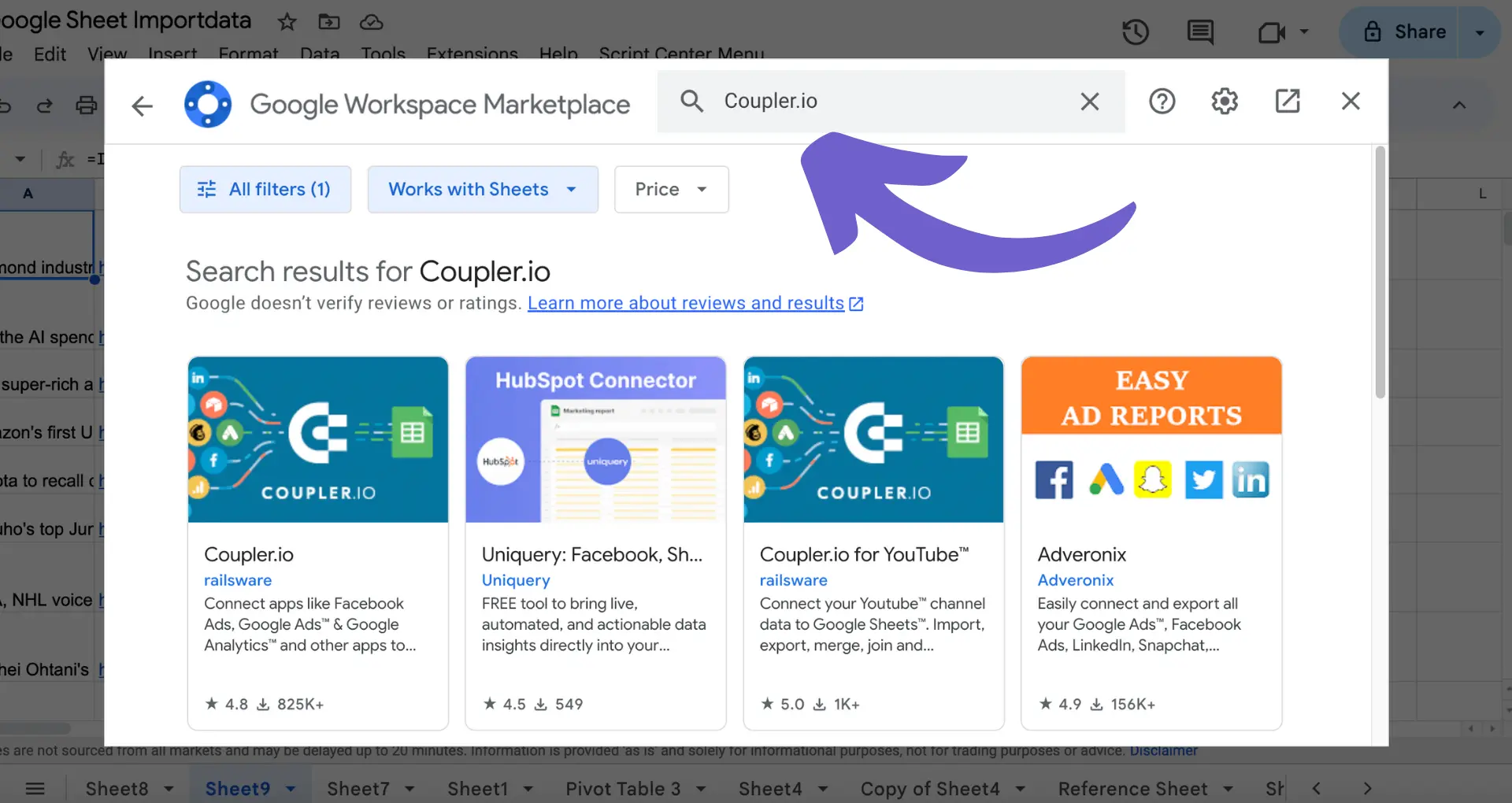
- Ability to transform data before importing, such as filtering, sorting, and creating custom columns
- Scheduled automatic updates to keep data in sync
- No need for complex formulas or coding
However, Coupler.io is a paid service, and the free plan has limitations on the number of imports and rows.
Google Apps Script
Google Apps Script is a scripting language based on JavaScript that allows you to automate tasks and extend the functionality of Google Sheets. With Apps Script, you can:
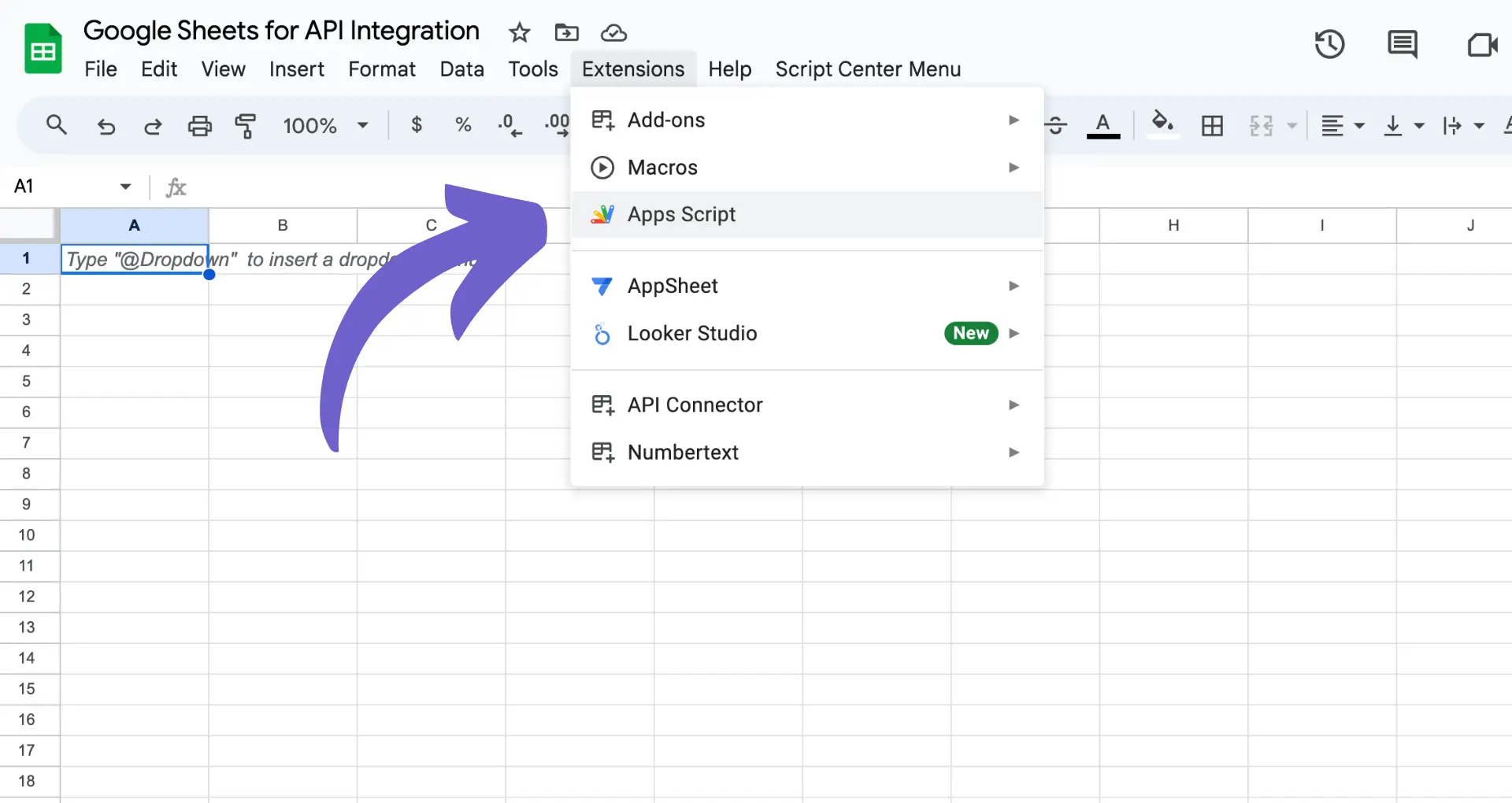
- Write custom functions to import data from other sheets or external sources
- Manipulate and format data during the import process
- Set up triggers to automatically run the script on a schedule
The main drawback of using Apps Script is that it requires coding knowledge, and maintaining scripts can be time-consuming.
For those looking for more advanced options, consider AI web scraping tools to automate data imports and keep your sheets updated.
Manual Copy and Paste
In some cases, the simplest alternative to IMPORTRANGE is to manually copy and paste the data from the source sheet to the destination sheet. This method is suitable when:
- The data set is small and doesn't require frequent updates
- You need to have full control over the data and formatting
- You don't want to rely on external tools or functions
The main limitation of manual copy and paste is that it can be tedious and prone to human error, especially for large datasets.
When deciding on an alternative to IMPORTRANGE, consider factors such as the size of your data, the frequency of updates, and your technical expertise. Coupler.io and Google Apps Script offer more advanced features and automation, while manual copy and paste may be sufficient for simple, one-time imports.
Automate Google Sheets with Bardeen's Powerful Playbooks
While the IMPORTRANGE function in Google Sheets offers a manual way to import data between sheets, automation can significantly enhance this functionality, saving time and reducing manual effort. Bardeen provides a suite of automation playbooks that leverage Google Sheets to streamline various tasks, from data collection to updating and enriching data.
- Find all emails from a list of websites in Google Sheets: This playbook automates the process of extracting email addresses from a list of websites directly into Google Sheets. It's perfect for lead generation and outreach campaigns, simplifying the data collection process.
- Copy all Github issues to Google Sheets: Ideal for project managers and developers, this playbook automates the transfer of GitHub issues into a Google Sheet, facilitating issue tracking and project management.
- Enrich email contacts and save to Google Sheets: Enhance your email marketing by automatically enriching email contacts with additional information and saving them to Google Sheets. This playbook streamlines the process of preparing and segmenting email lists for targeted campaigns.
By leveraging these playbooks, users can automate repetitive tasks, enrich data for deeper insights, and maintain more organized and up-to-date information in Google Sheets. Explore these automation opportunities to maximize efficiency and productivity in your workflows.






.svg)
.svg)
.svg)
